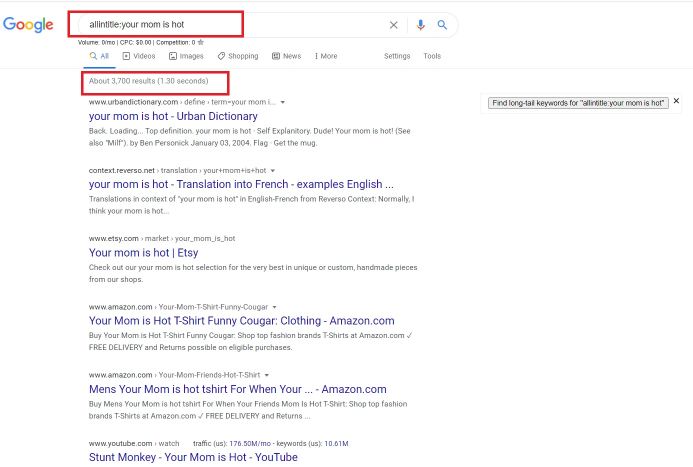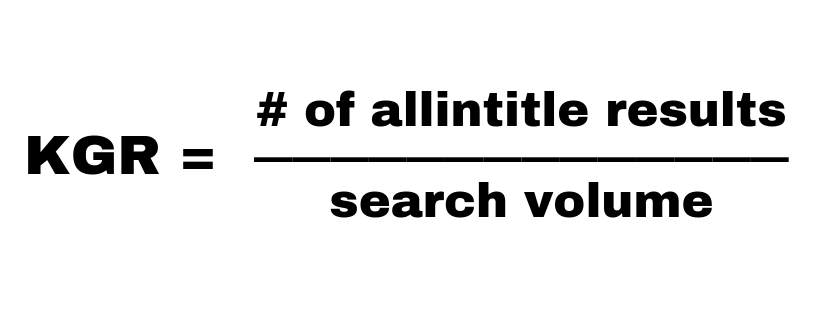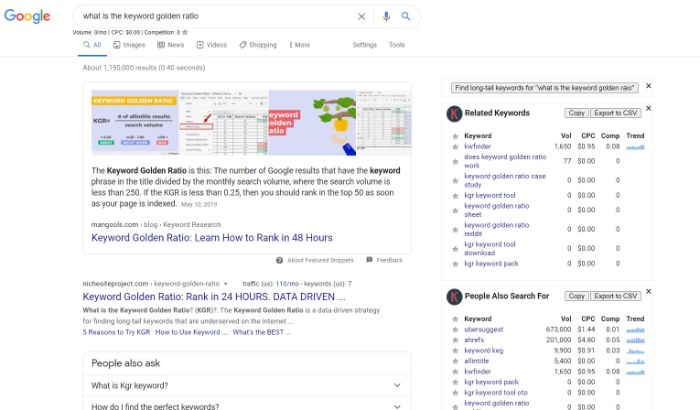Understanding the Keyword Golden Ratio
Join the 1,000+ brands that trust us for their link building.
Low competition keywords are sought after by beginners and seasoned veterans looking to boost traffic and capture quick wins. Long tail keywords are usually the low comp terms that people target to make some easy money.
The Keyword Golden Ratio (KGR) theory was developed to target long tail keywords that are overlooked by the competition with a data-driven method aimed at ranking in the top 100 SERP results in a few days or less. Some keywords may get ranked in the top 10 in less than 24 hours.
KGR has gained a lot of traction since its inception, due to an aggressive promotional campaign from its creator, Doug Cunnington, who claims that it’s one of the best ways to get fast results from a new site. But does it stand up to the hype?
This article is going to explain what KGR is and how it works, tips on how to implement it yourself, and why people believe in its success. In the end, you’ll be able to decide whether the KGR method is right for you.
What is Keyword Golden Ratio?
The Keyword Golden Ratio (KGR) is essentially a keyword selection technique (or hack) that proponents claim will generate traffic and boost revenue for a new website by helping you find exceptionally low competition long tail terms in Google that can potentially rank in the top 50 within 24 hours (or a few days).
Or maybe if you’re a bigger site in the SERPs, easily tackle some medium tail keywords, fat tail keywords, or more competitive terms in general.
KGR is the proportion of Google “allintitle” results per monthly search volume (less than 250), and provides a simple quantitative measure of competition for long tail keywords or phrases.
The KGR is a simple formula that’s expressed as the number of Google search results with a keyword in the title divided by the keyword’s monthly search volume (where search volume is 250 or less).
In other words, the ratio tells you how many search results an individual user will find with a particular keyword in the SEO title per the keyword’s search volume (less than 250).
The result of this calculation will give you three ranges to draw assumptions about the competitiveness of a keyword phrase: a KGR of less than 0.25, between 0.25 and 1.00, and greater than 1.00.

A KGR of less than 0.25 is considered the sweet spot and indicates an underutilized word or keyword phrase with low competition in Google. Proponents of KGR theory, like Doug Cunnington, believe these keywords will rank in the top 100 in a few days or less (sometimes much better).
A KGR between 0.25 and 1.00 is a sign of light to moderate competition and means you will rank in the top 250 as soon as possible. Finally, a KGR above 1.00 means the keyword is relatively competitive and harder to rank for because there are more search results than monthly volume. This means the average user will be flooded with pages to visit concerning a keyword phrase.
For example, if a keyword has 40 allintitle results with a search volume of 200 then its KGR is 0.20, and possibly ripe for the picking (less than 0.25). It means on average any 5 users are looking at the same individual search results. This is considered a good KGR term.
Now let’s dive into the complete process of figuring out the Keyword Golden Ratio (KGR) for any keyword or phrase using some common tools.
How To Figure Out Keyword Golden Ratio
Remember that the Keyword Golden Ratio formula is the (# of allintitle search results) / (monthly search volume).

In case you don’t know, “allintitle” is an advanced Google search command that only displays results that have a specific keyword or phrase in the title of a web page. An allintitle search query is typed in the search bar like this:
“allintitle:space bugs from mars”.
Note that you do not put a space after the colon.
Allintitle results show you the keywords that sites are specifically targeting with SEO techniques. It provides a sharper picture of competition that’s aimed specifically at a keyword compared to general search results.
The process of calculating the Keyword Golden Ratio is very straightforward. You simply need two essential components of keyword research: allintitle results and monthly search volume.
You can use a few efficient tools that you may already use for keyword research in general. Basically, any keyword research tool or site explorer will work. You can also use Excel to organize your data and automate the calculations.
To find keywords we recommend a tool we use called Keywords Everywhere because it’s cheap and efficient. You can also use SEMRush or Ahrefs to gather information on keywords like search volume and keyword difficulty.
We’ve written a comparison on Buzzsumo and Ahrefs here if interested.

The first thing you do is find keywords and relevant keyword suggestions. Google’s Autocomplete service comes in handy for kick-starting some ideas after you’ve typed an initial seed word in the search bar.
One of the best keyword formats to use when searching like a buyer is to use the “best (product or service) for (specific application or user or price range)”. So examples would be “best recipes for gravlax,” “best tutoring for preschoolers,” or “best strap-on under $100”.
You can combine words and phrases the more you drill down into niche topics and find less competitive keywords. The more specific, or long tail, a keyword phrase is the less competition there will be trying to rank for it.
Ahrefs and SEMRush are good for exploring the inner pages of big websites to discover niche keyword ideas.
Continuing with the process, use Keywords Everywhere to create a list of related keywords with search volumes of less than 250 after you’ve thought of a seed term. If you’re using SEMRush, then filter out suggestions with less than 250 search volume and relatively low keyword difficulty (KD).
Once you’ve chosen a specific keyword phrase from your related keyword ideas having a monthly search volume of less than 250, it’s time to filter out how many allintitle results exist for it. Enter the search phrase after “allintitle: ” in the Google search bar and count the results.
Plug the number of allintitle search results and monthly search volume for the keyword into the formula to arrive at the KGR for that given keyword. Simple. If the KGR is less than 0.25, then you’ve found your first potentially successful KGR term.
Keep in mind that you may find a phrase with 0 allintitle search results. That’s okay as long as there exists low search volume for that keyword. You can be the first person to optimize a web page or blog post for a specific keyword using allintitle.
Excel comes in handy when you’re already experienced at keyword research and topic discovery. If you can create a list of ideas pretty quickly then you should use some type of spreadsheet or organization tool to collect and analyze your data.
Now you know how to find keywords and use tools to figure out the Keyword Golden Ratio (KGR) for them. Let’s discuss why people think KGR works and what may be good or bad about using the technique to find low competition keywords.

The Theory On Why It Works
There are several reasons why people believe the Keyword Golden Ratio technique works.
Proponents of this technique believe that if you post a content piece targeting KGR keywords then the article should rank in the top 50 in a few days or even hours. They love seeing their brand new sites rank higher than already established sites in the SERPs.
They believe that the quick wins offered by KGR will build confidence and keep beginners motivated. Building a successful niche site takes time, but being able to rank quickly shows your work can pay off sooner than expected.
The KGR technique also helps with content prioritization. It gives users a concrete guideline to aim for by narrowing down keyword lists and targeting low-hanging fruit so you’re not just blindly searching for keywords. Its quantitative nature provides objectivity.
Keyword Golden Ratio practitioners also believe that simply using the technique makes them stand out from the pack because it’s a technical process that few people use and requires more work (and rules) to find keywords.
It’s worth mentioning that the holy trinity of relevance, authority, and power really helps a lot for ranking whether a KGR phrase is used or not. You may notice considerable differences in rank depending on these factors. Ranking is easier if your website already has good authority and domain age.
You’re probably wondering why KGR emphasizes a monthly search volume of 250 or less. Its creator, Doug Cunnington, firmly believes that high search volume means high competition and is harder to rank for.
He did extensive testing and chose 250 as the default parameter for the formula. Honestly, you can experiment with that number yourself. You may discover that you can rank even if you raise the search volume requirement for keywords.
So what do we think about the Keyword Golden Ratio?
Our Personal Take
Anything in SEO that’s considered a “golden rule” is probably going to change over time. For example, many years ago you could’ve ranked in the first page SERPs for keywords with 10,000 monthly search volume without too much effort.
Things have evolved. Competition has increased. That’s why the KGR technique is aimed at low competition terms with less than 250 search volume. That’s a big difference from a search volume of several thousand per month.
Like any exploitative opportunity, people will catch on and apply it for themselves thus diminishing the profitability for everyone.
While we think KGR was something worth looking at in the past, and may still be worthwhile to explore now, our new way of doing things takes more time and is more comprehensive.

For the most part, I don’t worry much at all with KGR as much as just using the search operators allintitle: and allinurl: to see how many results pop up.
We currently prefer to use keywords everywhere and Mozbar to analyze SERPs, and can dive in further by using allintitle: and allinurl: search operators for terms we find and are interested in going after.
Here are some tutorials on how we do keyword research:
How To Find Low Competition Keywords
Using AllinTitle: and Allinurl: to find easier keywords
We’ve found that people exclusively doing keyword research based on KGR aren’t as successful as some blog posts may lead you to believe.
Because KGR targets long tail keywords which are longer than most terms, issues sometimes arise with keyword cannibalization. This occurs when you have too many related posts competing with one another for the same SERPs. Sometimes a bigger, broader article is actually a better way to go after some of these long-tail keywords.
KGR keywords are probably not going to rank if there aren’t any similar sites to yours that show up in the search results. For example, if you find a good KGR term and all the relevant sites are YouTube videos, then you’re most likely not going to rank if it’s not what the SERP calls for.
Sometimes you’ll have difficulty even finding good KGR keywords. And you may not rank if you only publish a single post for a KGR term because, according to its creator, KGR only works well at scale.
KGR is a cool concept, but it’s not a bulletproof way to do keyword research in my opinion. Like most things in SEO, it’s prob worthwhile to look at, but should be used in conjunction with multiple tools and methods to get a better picture.
Conclusion
The Keyword Golden Ratio is a catchy-sounding technique that aims to deliver quick results for people looking to rank and make money as soon as possible. But like most things in SEO, it may not always work or hold up to the evolving competition.
New site owners need traffic and quick wins to feel like they’re doing things correctly. KGR proponents claim that it can help you rank in the top 50 in a short amount of time because it gives users low competition keywords to exploit.
KGR also assumes that keywords positioned in SEO titles give a strong, competitive ranking signal. While it most certainly is, it’s one of several factors we look at including the permalinks themselves, and the holy trinity (power, authority, relevance) of the site.
Still, KGR is based on sound logic and it’s easy to implement. You only need a few simple tools to get started. Giving it a go won’t cost you much time or resources, and can still lead to big wins.
It’s up to you to decide whether you believe in simple formulas for success or if you want to dive a little deeper into more comprehensive ranking strategies to find keywords.
Contributing Author: Brian Kihneman
 Article by:
Article by:
Nicholas Altimore
Hey I'm Nick, the Founder/Director here at SirLinksalot. I have a passion for building online businesses and taking websites to the next level with the help of my amazing link building team.
 Questions or Comments?
Questions or Comments?
We are active in our Facebook Group seven days a week and would love to hear from you. Ask us questions, learn from other group members, and share your knowledge.
Related Posts
Ready To Start Building Your Rankings?
Your link building journey to the top of Google starts today!
Apply for Managed Link Building to get a free analysis and game plan, or order backlinks a la carte.
Link building services that work.


